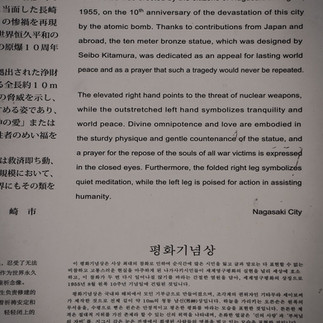Where Madame Butterfly and Atomic Bombs collide
- colesjoholm
- Nov 21, 2023
- 3 min read
Updated: Nov 25, 2023
There were only sad tears today.
Too much to absorb.
I feel cheated by American History classes and the tinted lens portrayed after what I learned today in Nagasaki.
Let’s start with the positive. Nagasaki is a stunning city. Very hilly and a combination of Chinese, Dutch and Japanese cultures. It is also home to one of only three Chinatowns in Japan.
Today likely ranks in the top two or three cruise ports alongside Geiranger Fjord, Norway + San Juan, Puerto Rico and Copenhagen, Denmark.
I started my ship sponsored shore excursion at the Nagasaki Peace Park. The large statue is meant to symbolize the Nuclear Bomb coming from sky with its upwards pointing arm and eternal peace with the arm extended horizontally.
Across a very large stone plaza is the Fountain of Peace. Water is used pretty extensively around the memorials and museums, as water was large unattainable after the bombing.
Numerous countries have donated sculptures and trees to honor those lost.
A short bus ride away is the Nagasaki Atomic Bomb Museum next door to Ground Zero or Hypocenter Park.
The bomb detonated at 11:02a on August 9, 1945 about 500 meters above the city. The devastation was caused in three parts. The blast. The heat. The radiation.
The Blast. 50% of the energy released was from the blast. All structures within 1 km were completely destroyed.
The Heat. Burnt everything beyond recognition. Tile roofs bubbled. Rocks melted together. 1/3 of city within 4 km were destroyed into rubble and ash.
At the time of the bombing, the city had a population of 240,000. Because most of the men were away in the war, the deceased and injured were mainly women, children and elderly. By December of 1945 more than 74,000 had died. Another 1/3 badly injured.
The Japanese Government categorized survivors into those who were:
Within 4 km at time of bombing
Within 2 km of Ground Zero within 2 weeks after the bombing.
The radioactive fallout causes death and cancer rates much higher than you would otherwise find, but because of the bomb detonating above ground, isn’t the same sort of wasteland like Chernobyl.
The Govt didn’t announce the nuclear bombing right away, just stated it was a new type of bomb. People flocked to help the injured without knowing the exposure to radiation. That lead to much illness and death for years afterwards.
The Atomic Bombing Museum put all of the facts into visual reality. The famous clock that remains intact that stopped at precisely 11:02a. Ceramic roof tiles from various distances around the Hypocenter that are charred and bubbled. Glass bottles that melted together into unrecognizable blobs, stacks of dinner plates, unbroken but now one solid block.
It was a lot to process.
I feel everyone in the world should visit Hiroshima or Nagasaki. We may feel very differently about Nuclear Warheads and Peace.
Origami Cranes, numbered in the hundreds of thousands are stranded together in stings of a thousand apiece, as it is believed that a maker of a thousand is granted one wish. Placed near entrances, near statues and monuments. The rainbow of colors and ornate detail leads to beauty in the chaos and devastation.
The day ended on a much lighter note at Glover Gardens. It’s “a park in Nagasaki, Japan, built for Thomas Blake Glover, a Scottish merchant who contributed to the modernization of Japan in shipbuilding, coal mining, and other fields. In it stands the Glover Residence, the oldest Western-style house surviving in Japan and Nagasaki's foremost tourist attraction.” (Wikipedia)
Also the setting of Madame Butterfly, the famous opera, it was a full circle moment, as Madame Butterfly happens to be the very first Opera I saw back in the late 90s while on a High School Drama trip. The MET was stunning. I fell in love with Opera and seeing Placido Domingo for your first Opera performances was pretty memorable.
Now nearly 30 years later, being in Nagasaki and having a similar but very different contextual impact on my life, I feel the two arcs connected into a full circle.
Bridging the past and today of my life.
Back onboard, I was invited by fellow LGBTQ traveler Kirian to attend the ship sailway party on the Helipad on the bow of the ship. Sailing underneath the Megami Ohashi Bridge with a backdrop of a vibrant orange and red sunset was a perfect end to a day from a city that won my heart.
Dinner tonight was among the best onboard a cruise ship. Lobster Salad with spicy Soba Noodles and a steak salad that was grilled to absolute perfection.
Overall, one of the top days in this amazing year. It was that good.
Signing off. Next stop is Taipei, Taiwan after a sea day.
Cole from Colorado
Praying for Peace.




























































































































































































































How beautifully you bring this to light for those of us not physically there with you. Yes, our history classes whitewashed a lot of our history, here and abroad. We went through Dachau in Germany and we also had a very visceral reaction.
thank you for this! C